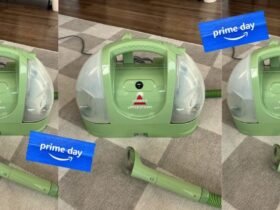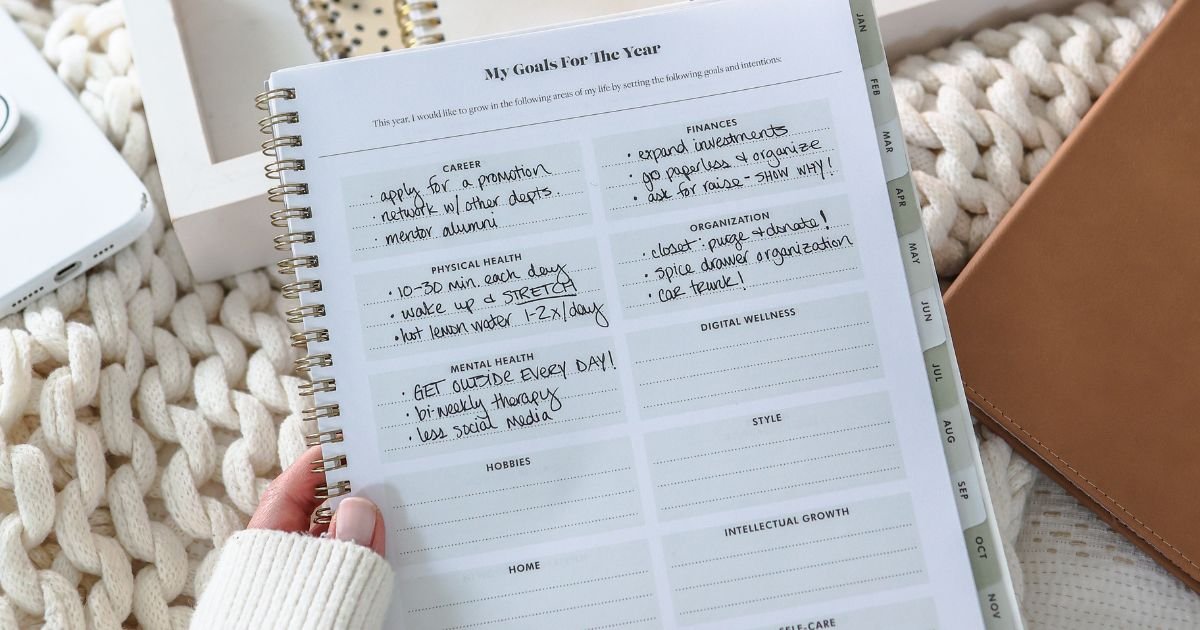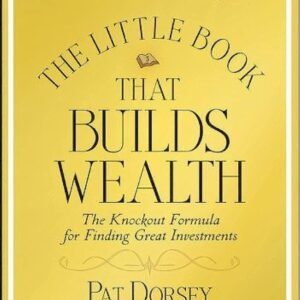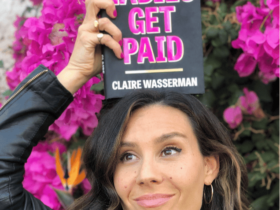Every year, I round up vision board supplies to dream about the year ahead and fill out reflection and goal-planning workbooks. Like most of us, I brainstorm goals for my career, relationships, social life, health, and more, and I think, “Certainly, I can accomplish all of these things by next year!” But despite my best goal-setting efforts and the deep excitement I feel for what’s to come, I can’t help but feel generally overwhelmed.
To be honest, I typically end up setting vague commitments, letting the year play out, and adjusting my path along the way, and that doesn’t always yield great results. Knowing this about myself, I wanted to try something new and as always, the internet had an answer for me. Inspired by a popular time management book, I picked up a copy of The 12 Week Year by Brian P. Moran and Michael Lennington to see what the hype was about and attempt to plan my success.
After reading Moran and Lennington’s framework and advice, I’m here to share what I learned from The 12 Week Year, how I’m leveraging it all to set meaningful, measurable goals, and whether or not it’s yielded results for me so far.
Brian P. Moran and Michael Lennington
Leading experts on execution and implementation, Brian P. Moran and Michael Lennington share a how-to guide for those who are seeking to improve their execution effectiveness from one year to just 12 weeks. This book will help you redefine your year to create clarity and urgency on what matters now and ultimately speed your journey to success.
What is a 12 week year?
According to Moran and Lennington, “A year is no longer 12 months, it is now only 12 weeks.” This allows us to redefine the traditional framework of a full year; however, it’s important to note that this isn’t the same as dividing a calendar year into four (like you would when you plan quarterly). You can start your 12 week year at any time and count 12 weeks from your starting point to determine when your year ends. Basically, you don’t have to start on January 1 if you want to start crushing your goals using this framework—you can start counting your 12 weeks whenever you want! And after the 12 weeks is over, you can start again right away or whenever you’re ready. There are no hard and fast rules!
How do you structure your days?
When you have 365 days to achieve your goals, you don’t have to be as strict with your time as you do when you only have 84. Each moment in each day is important in a 12 week year, so structuring your day and outlining your tactics (or your to-do list) is crucial for making progress toward your goals. Your daily actions are what drive you toward actual change, so plan your days with actionable, specific, and time-bound tasks. For example, if you are planning to prioritize your health as a goal, some of your daily to-dos might include incorporating 30 minutes of movement each day on your lunch break (whether it’s a short walk, a workout, or light stretching) and eating at home five out of seven nights of the week.
“Your daily actions are what drive you toward actual change, so plan your days with actionable, specific, and time-bound tasks.”
The tactics you set out to do should be clear enough that you can tell right away if you’re achieving them. Otherwise, it will be hard to tell at the end of your day, week, and full 12 weeks if you accomplished what you intended.
How can you be the most intentional with your limited time?
Achieving your goals requires more than planning and luck. You’ll also need to ensure you’re using your time intentionally. Moran and Lennington discuss intentionality and how, in order to accomplish your goals, you have to be intentional about how and where you invest your time. Time-blocking is a great way to ensure all of your time is well-spent. In the book, the authors discuss three helpful types of time blocks that hold a specific purpose, whether it’s to power through hard work or simply take a much-needed rest—because both are important for achieving your goals.
- Strategic blocks: This is a three-hour block of uninterrupted time that you can schedule each week for deep, distraction-free concentration.
- Buffer blocks: This is a block for unplanned and low-value activities that can feel rather time-consuming, and the allotted time varies for each person.
- Breakout blocks: This is another three-hour (or more) block of time that is spent away from your work. Think of this as free time to be totally disconnected.
How do hold yourself accountable throughout a 12 week year?
Determining your weeks and structuring your days will help you pull together a strong plan, but it’s essential to implement accountability and progress checks to guide you. Moran and Lennington recommend spending 15-20 minutes at the beginning of each week and the first five minutes of each day reviewing your progress. This can help you determine the areas you’re doing a good job in, whether or not you’ve been allocating your time effectively, and where you might be falling behind and need to restructure your tasks and plans. Checking in with your progress frequently keeps your goals top of mind, too.
Moran and Lennington also suggest implementing a scorekeeping method to measure your weekly efforts. This doesn’t have to be complicated or overly strict, but it should give you a good idea as to whether you met your goals for the week or not. To do this, review the tactics you intended to complete throughout the week and cross off what you actually finished. Then, count the number of tactics you completed and divide it by the total number you intended to do. This will give you your score for the week. Moran and Lennigton found that if you achieve a minimum of 85 percent each week, you’re likely to hit your goals at the end of the 12 week year!
Regular accountability checks and scorekeeping can let you know if you are truly making progress toward your goals because let’s face it: If we don’t measure ourselves, it’s easy to tell ourselves we’re making progress, only to come up short. These check-in points also allow you to assess whether you set the right tactics for yourself, which means that if there’s a tactic you aren’t hitting week after week, you should reassess it and adjust if needed.
How do you achieve your goals in less time?
The concept of the 12 week year is also built on three principles that, when executed well, drive personal and professional success. To achieve your goals, Moran and Lennington believe accountability, commitment, and harnessing greatness in each moment is crucial. While we already reviewed the importance of accountability and understand the importance of being committed to your work and your goals, harnessing greatness is a principle I had never considered before.
A lot of us think that greatness comes after we achieve our big dreams—like we’ll be happy when we achieve something—but the real power lies in believing in our greatness throughout the entire process. When we do this, we are more likely to do the things we need to feel great and enjoy the process along the way.
With the help of these three principles, we know our goals, we know what we need to do to achieve them, and we aren’t afraid to set boundaries around our lives and schedules to help us do so. All of these things bring us closer to success.

How to implement the 12-week year plan
Determine your vision
Don’t let a “shorter year” deter you from dreaming big. Instead, let it motivate you to get extra clear on what you want out of your life and career. Do you want to buy a house in the next five years? Do you want to take on your side hustle full-time? These are achievable! Now, allow your long-term vision to guide the short-term goals you’ll set your eyes on for the next 12 weeks.
Set 1-3 goals
There is power in simplicity, so don’t overcommit yourself or overcomplicate your goals. Set 1-3 short-term goals that will propel you forward toward your long-term goals. For example, if you want to buy a house, maybe you decide to save $1,000 in the next 12 weeks. These should be specific and measurable.
“It’s essential to get specific about what you can do in the short term to take meaningful steps toward your bigger dreams.”
Outline your tactics
Now that you have goals identified, the next step is to outline the tactics you will do on a daily or weekly basis that will help you achieve them. These should also be specific and measurable. For example, if you want to take on your side hustle full time, maybe you decide to reach out to one potential client every day or work on your website for 30 minutes before bed. These will help you build consistent progress over 12 weeks.
Time-block your days
It’s time to get specific about how you spend your time. Moran and Lennington swear by strategic, buffer, and breakout blocks. Take a look at your daily and weekly to-dos and identify when you will achieve your tactics. In doing so, be sure to schedule some time away from work too.
Assess your progress weekly
Get honest with yourself: did you do everything you set out to do? If you did, great! If not, no worries. By assessing your progress weekly through the scorekeeping method that Moran and Lennington recommend, you can adjust your tactics and goals as needed. For example, if you planned on working on your website for 30 minutes but you only did that 50 percent of the week, adjust your goal to better fit your schedule. There is no shame in that! Flexibility is crucial.
Review your results and reset
Once you make it to the end of the 12 weeks, assess your weekly results as a whole. What challenges did you face? What can you celebrate? Is there anything you would do differently next time? This is your opportunity to enter the next 12 weeks more informed and motivated to make more progress toward your vision.
How I’m using 12 week years to crush my goals this year
I’m creating short-term visions
In the same way that people make a vision for the entire year, I made a vision board for my 12 week sprint. For the first time, I felt less pressure to do ~all the things~ and instead focused on a short-term vision. Moran and Lennington note that it’s essential to get specific about what you can do in the short term to take meaningful steps toward your bigger dreams. To do this, you should ask yourself a series of questions to identify what you want to achieve. Below are a few questions that are recommended in the book, as well as a few of my own, that I sprinkled in to ask myself to define my short-term vision and determine my goals.
- What is most important to me in all aspects of my life?
- How much time freedom do I want?
- What income do I need (versus want)?
- What do I find fulfilling?
- What dreams do I have, and what risks or barriers are in my way?
- Where do I feel most purpose-led?
I found that it was refreshing and exciting to let my mind wander in these directions. This process really helped me capture what I wanted to achieve without the pressure to be perfect or the rush to do everything all at once.
I’m determining measurable goals
According to the book, many 12 week plans should only include two or three goals. Since time is limited, they should be specific and measurable, as we discussed earlier. Ahead are the goals I defined for myself, as well as how I am planning to achieve them, in case you need some examples or inspiration for your own planning!
“This process really helped me capture what I wanted to achieve without the pressure to be perfect or the rush to do everything all at once.”
Grow my professional network
As much as I know that building a strong professional network and making connections is important (especially in an ever-changing job market), I don’t always prioritize time to grow mine. So, I’ve set this as a goal as part of my first 12 week plan to connect with and learn from like-minded professionals and expand my reach as a freelance writer.
To achieve this goal, I plan to post on LinkedIn at least three times per week, attend one networking event by the end of my 12 week year, and spend at least one hour per week engaging with other freelancers. As you can tell, these are all specific and measurable, so they are easy to score myself on.
Adopt a consistent morning routine
I know from experience that my mental health is better, that I’m more productive during the day, and that I perform better when my morning routine is consistent. For my first 12 week year, I knew that because of these things, I should give my existing morning routine an overhaul as it affects all aspects of my life and, subsequently, my goals.
To achieve this, my goal is to wake up at 6:30 am every weekday (no snooze button allowed), brush my teeth as soon as I get up, and get changed out of my pajamas before I leave my bedroom. These things will help me feel less groggy and more confident and prepared to take on the day. In addition to this, drinking at least one glass of water before I reach for a cup of coffee and setting a strict “no social media until after 10:00 a.m.” rule is present on my daily to-do list. With these things in place, I anticipate seeing my productivity and mental health improve significantly.
I’m documenting my progress and planning ahead
I used my first attempt at a 12 week year as an excuse to buy another planner I didn’t need (because duh) so I could track my progress along the way. On Sunday evenings, before bed, I document my progress by scoring my week. This usually looks like a written “Heck yes, I did it!” or “I missed this goal this week” for each of the tactics I outlined at the beginning of the week (or a simple checkmark and an X, depending on my mood).
Once I review my score from the previous week, I use that to guide the following. For example, if I didn’t post as many times on LinkedIn as I planned to the week prior, I make sure to prioritize that or do an extra post. I also use this time to put blocks on my calendar for different activities, ensuring I leave little wiggle room for determining how best to spend my time in the moment since breakout blocks (reminder: these are the time blocks spent away from work) are equally as productive, according to Moran and Lennington.
Is the 12 week year worth the hype?
I’m only a few weeks in, but so far, I’m enjoying this framework and already seeing benefits. I don’t mean to brag, but since I started my first 12 week year, my scorecard has averaged a solid 90 percent! As a recovering perfectionist, I have to be honest and admit that because I always want a perfect score, I find it challenging to be honest with myself about my progress. However, I have recognized throughout this process so far that if I score perfectly, my goals might be too easy. Taking the time to pause and adjust for the greater good of my goals is all a part of growing and learning.
The 12 week year has taught me to find the excitement in goal-setting and fresh starts instead of feeling overwhelmed by them. I can’t wait to capture more of that “new year, better me” energy beyond the month of January and achieve more goals regularly, knowing that I have the framework and support to do it, thanks to Moran and Lennington.

About the Author
Alyssa Towns, Contributing Career & Finance Writer
Alyssa Towns is a Denver-based writer and communications professional whose writing and expertise have appeared in Business Insider, Clockwise, G2, The Knot, Passion Planner, Thrive Global, and more. In addition to being a freelance writer, Alyssa has a background in internal communications and change management and is passionate about helping humans thrive in the workplace.

ABOUT THE AUTHOR
Hailey Bouche, Associate Editor
As an Associate Editor for The Everygirl, Hailey Bouche oversees, writes, and edits content across various categories on the site. From the pitching stage through publishing, she works alongside the team to ensure that the content that our readers see every day is inspiring, relatable, and timely.



















Leave a Reply